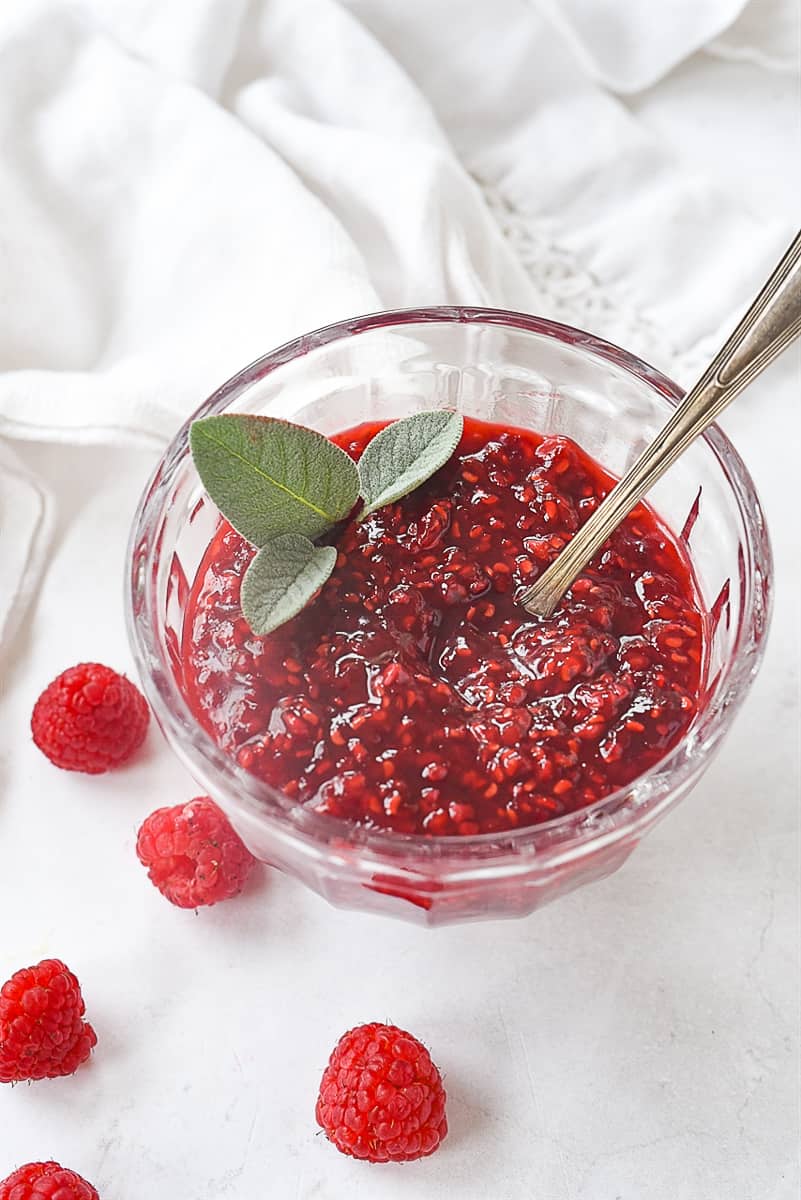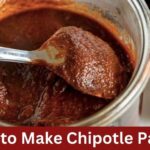Raspberry chipotle sauce is a delightful blend of sweet, tangy raspberries and smoky, spicy chipotle peppers. This versatile sauce adds a burst of flavor to a variety of dishes, from grilled meats to sandwiches and even as a dip. In this comprehensive guide, we’ll walk you through the step-by-step process of making your own homemade raspberry chipotle sauce. Get ready to elevate your culinary creations with this irresistible condiment!
Raspberry chipotle sauce is a unique combination of sweet and spicy flavors that adds depth and complexity to any dish. Whether used as a marinade, glaze, or dipping sauce, its vibrant taste profile makes it a favorite among food enthusiasts. The sweetness of fresh raspberries complements the smoky heat of chipotle peppers, creating a harmonious balance of flavors that tantalizes the taste buds.
Ingredients

- 2 tablespoons olive oil
- 2 jalapeños with seeds, minced
- 2 cloves garlic, minced
- 4 teaspoons adobo sauce (from a can of chipotle peppers in adobo sauce)
- 12 ounces raspberries
- 1/4 cup apple cider vinegar
- 1/4 cup water (if using fresh berries)
- 1/2 teaspoon kosher salt
- 2 tablespoons brown sugar
- 1/4 cup white sugar
Cooking Instructions
Step 1: Sauté the Aromatics

- Heat Olive Oil: Start by heating olive oil in a skillet over medium heat. The olive oil serves as the cooking medium and adds richness to the sauce.
- Add Minced Jalapeños: Once the oil is heated and shimmering, add the minced jalapeños to the skillet. Jalapeños not only contribute heat to the sauce but also impart a distinctive flavor profile with hints of fruitiness and earthiness.
- Cook Until Softened: Allow the jalapeños to cook for approximately 5 minutes, stirring occasionally, until they become softened. This cooking process helps to release the flavors and natural oils from the jalapeños, intensifying their aroma and heat.
- Reduce Heat and Add Garlic: After the jalapeños have softened, reduce the heat to low and add the minced garlic to the skillet. Garlic adds depth and complexity to the sauce, with its pungent yet savory flavor profile.
- Cook Briefly: Cook the garlic along with the jalapeños for about 2 minutes, stirring occasionally to prevent it from burning. This brief cooking time allows the garlic to mellow and infuse its aromatic essence into the oil without becoming overly browned or bitter.
- Infuse with Adobo Sauce: Finally, incorporate the adobo sauce from the canned chipotle peppers. Adobo sauce is a key ingredient that provides smoky undertones and a hint of tanginess to the sauce. Stirring it into the skillet allows its flavors to meld with the other aromatics, creating a cohesive base for the raspberry chipotle sauce.
Step 2: Add Raspberries
- Incorporate Fresh Raspberries: Once the aromatics (jalapeños, garlic, and adobo sauce) have been sautéed and infused with flavor, it’s time to introduce the fresh raspberries to the skillet. The raspberries should be gently stirred into the aromatic mixture, allowing them to coat with the flavorful oils and spices.
- Cook Until Breakdown: As the raspberries begin to heat up, they will gradually soften and release their juices. It’s important to cook them until they break down completely, as this process helps to extract their natural flavors and sweetness. This typically takes about 10 minutes of gentle cooking over low heat.
- Encourage Juices Release: While cooking, you can use a spatula to gently break up the raspberries if desired, helping them release their juices more effectively. However, raspberries will naturally soften and break down on their own as they heat up.
- Enhance Flavor: As the raspberries cook and break down, their juices mingle with the aromatics, infusing the sauce with a burst of fruity flavor. The combination of sweet raspberries with the spicy undertones of the jalapeños and chipotle peppers creates a dynamic flavor profile that is both complex and satisfying.
Step 3: Simmer the Sauce
- Incorporate Additional Ingredients: Once the raspberries have broken down and released their juices, it’s time to add the remaining ingredients to the skillet. This includes apple cider vinegar, water (if using fresh berries), kosher salt, brown sugar, and white sugar. These ingredients add acidity, sweetness, and seasoning to the sauce, balancing out the flavors and enhancing its overall taste profile.
- Simmer Over Low Heat: After adding the additional ingredients, allow the sauce to simmer over low heat. It’s important to maintain a gentle simmer throughout the cooking process to prevent the sauce from boiling too vigorously, which could cause it to splatter or burn.
- Reduce by Half: As the sauce simmers, excess liquid evaporates, and the sauce gradually thickens and reduces in volume. This typically takes around 30 minutes, but the exact cooking time may vary depending on the desired thickness of the sauce and the intensity of the heat.
- Stir Occasionally: While the sauce is simmering, it’s important to stir it occasionally to prevent it from sticking to the bottom of the skillet and ensure even cooking. Stirring also helps distribute the flavors evenly throughout the sauce, resulting in a more balanced final product.
- Monitor Consistency: As the sauce cooks, keep an eye on its consistency. You want it to be thick enough to coat the back of a spoon but still pourable. If the sauce becomes too thick, you can add a little water or apple cider vinegar to thin it out to your desired consistency.
- Taste and Adjust Seasoning: Throughout the simmering process, taste the sauce periodically and adjust the seasoning as needed. You can add more salt, sugar, or vinegar to balance the flavors to your liking. Remember that the intensity of the flavors will continue to develop as the sauce simmers, so it’s important to taste and adjust accordingly.
Step 4: Blend the Sauce

- Allow the Sauce to Cool: Before blending the sauce, it’s important to allow it to cool for a few minutes. This helps prevent steam from building up in the blender or food processor, reducing the risk of splattering or burning yourself.
- Transfer to Blender or Food Processor: Once the sauce has cooled slightly, carefully transfer it to a blender or food processor. Be sure to use a heatproof spatula to scrape any remaining sauce from the skillet to ensure none of the flavorful mixture goes to waste.
- Puree Until Smooth: Blend or process the sauce on high speed until it reaches a smooth and uniform consistency. Depending on the power of your blender or food processor, this usually takes about 30 seconds to 1 minute. You may need to pause occasionally to scrape down the sides of the blender or food processor to ensure all the ingredients are evenly incorporated.
- Adjust Consistency if Necessary: As you blend the sauce, pay attention to its consistency. If the sauce is too thick for your liking, you can add a little water or apple cider vinegar to thin it out to your desired consistency. Conversely, if the sauce is too thin, you can continue blending or add a thickening agent such as cornstarch or arrowroot powder to achieve the desired thickness.
- Taste and Adjust Seasoning: Once the sauce is blended, taste it again and adjust the seasoning if necessary. You may find that the flavors have intensified during the blending process, so it’s important to taste and adjust accordingly. Add more salt, sugar, or vinegar as needed to achieve the perfect balance of sweet, spicy, and tangy flavors.
- Pour into a Bowl: Once the sauce is blended to your desired consistency and flavor, carefully pour it into a serving bowl or container. Use a spatula to scrape any remaining sauce from the blender or food processor to ensure you get every last drop of deliciousness.
Step 5: Serve or Store
-
- Transfer to a Serving Bowl: Carefully pour the freshly blended sauce into a clean serving bowl or dish. Use a spatula to scrape any remaining sauce from the blender or food processor to ensure you get every last drop of deliciousness.
- Allow to Come to Room Temperature: Let the sauce come to room temperature before serving. This allows the flavors to fully develop and ensures that the sauce is at its peak deliciousness when enjoyed.
- Serve and Enjoy: Once the sauce has reached room temperature, it’s ready to be served and enjoyed! Use it as a marinade, glaze, or dipping sauce for your favorite dishes, and savor the delicious blend of sweet, spicy, and smoky flavors.
Store for Later Use:
If you’re not planning to use the raspberry chipotle sauce immediately, follow these steps to store it properly:
- Cool Completely: Allow the blended sauce to cool completely to room temperature before storing. This helps prevent condensation from forming inside the storage container, which could potentially lead to spoilage.
- Transfer to an Airtight Container: Once the sauce has cooled, carefully transfer it to a clean, airtight container. Glass jars or plastic containers with tight-fitting lids work well for storing sauces.
- Refrigerate or Freeze: Depending on when you plan to use the sauce, you can either refrigerate it for short-term storage or freeze it for longer-term storage. Be sure to label the container with the date so you can keep track of how long the sauce has been stored.
- Thaw Before Using (if Frozen): If you choose to freeze the sauce, be sure to thaw it in the refrigerator overnight before using. This allows the sauce to thaw evenly and ensures that it retains its delicious flavor and texture.
- Enjoy Within Recommended Timeframe: Raspberry chipotle sauce can typically be stored in the refrigerator for up to 2 weeks or frozen for up to 3 months. Be sure to enjoy the sauce within these recommended timeframes for optimal freshness and flavor.
Tips and Variations

Desired Spice Level: If you prefer a milder sauce, consider deseeding one or both of the jalapeños before mincing them. Removing the seeds reduces the heat intensity while still retaining the jalapeño flavor.
Water Content: When using frozen raspberries, omit the additional water called for in the recipe. Frozen raspberries tend to release more liquid during cooking, so adding water may result in an overly thin sauce. Adjusting the water content ensures the sauce maintains the desired consistency.
Reducing Sugar Content: Compared to store-bought versions, this homemade raspberry chipotle sauce contains less sugar. However, you can further reduce the sugar content if desired. Keep in mind that sugar contributes not only sweetness but also helps balance the acidity and spiciness of the sauce. Experiment with reducing sugar gradually while tasting the sauce to maintain flavor balance.
Additional Ingredients: Feel free to experiment with additional ingredients to customize the sauce to your taste preferences. Consider incorporating spices such as ginger, smoked paprika, or cumin for added depth of flavor. Lime zest or juice can provide a bright citrusy note, while honey or maple syrup can enhance sweetness.
Fresh Herbs: Adding fresh herbs like cilantro or mint can impart freshness and complexity to the sauce. Simply chop the herbs finely and stir them into the sauce after blending for a burst of herbal aroma and flavor.
Tasting Throughout Cooking: As the sauce cooks, taste it periodically and adjust the seasoning as needed. Since the intensity of flavors can vary depending on factors such as ingredient freshness and personal taste preferences, tasting allows you to fine-tune the sauce to your liking. Add more salt, sugar, or acidity (such as vinegar) as necessary to achieve the perfect balance of flavors.
Proper Storage: Store any leftover raspberry chipotle sauce in an airtight container in the refrigerator for up to 2 weeks. Alternatively, the sauce can be frozen for up to 3 months for longer-term storage. Be sure to thaw frozen sauce in the refrigerator before using and consume it within the recommended timeframes for optimal quality.
Serving Suggestions

Marinade and Glaze:
- Pork and Chicken: Use raspberry chipotle sauce as a marinade for pork chops, tenderloin, or chicken breasts. Allow the meat to marinate for several hours or overnight to impart maximum flavor. Grill, bake, or roast the marinated meat until cooked through, brushing with additional sauce for a glossy glaze just before serving.
- Salmon and Steak: Brush raspberry chipotle sauce over grilled or seared salmon fillets or steak during the final minutes of cooking. The sauce caramelizes slightly, creating a mouthwatering glaze that enhances the natural flavors of the fish or meat.
Sandwiches and Wraps:
- Turkey or Chicken Sandwiches: Spread raspberry chipotle sauce onto bread or rolls before layering with sliced turkey or chicken, crisp lettuce, juicy tomatoes, and creamy avocado. The sweet and spicy sauce adds a zesty kick to classic sandwiches, transforming them into gourmet delights.
- Wraps and Burritos: Drizzle raspberry chipotle sauce over fillings for wraps or burritos, such as grilled vegetables, rice, beans, and shredded cheese. The sauce adds a burst of flavor and moisture, tying all the ingredients together in a deliciously cohesive package.
Appetizers and Snacks:
- Dipping Sauce: Serve raspberry chipotle sauce as a dipping sauce for appetizers such as crispy chicken tenders, onion rings, or sweet potato fries. The combination of sweet, spicy, and smoky flavors adds an irresistible kick to every bite, making it a crowd-pleasing party favorite.
- Cheese Platter: Pair raspberry chipotle sauce with a selection of cheeses, such as sharp cheddar, creamy brie, or tangy goat cheese. Spread a dollop of sauce onto crackers or crostini, then top with cheese for a sophisticated appetizer that balances sweet, spicy, and savory flavors.
Main Course Accompaniments:
- Grilled Vegetables: Drizzle raspberry chipotle sauce over grilled vegetables, such as zucchini, bell peppers, and eggplant, before serving. The sauce adds a burst of flavor and moisture to the vegetables, elevating them from simple side dishes to standout stars of the meal.
- Salads: Use raspberry chipotle sauce as a dressing for salads, such as mixed greens, spinach, or grain salads. The sweet and tangy sauce pairs beautifully with fresh vegetables, fruits, and nuts, adding a delightful flavor contrast to every bite.
Creative Uses:
- Stir-Fry Sauce: Incorporate raspberry chipotle sauce into stir-fry dishes for a unique twist on traditional Asian flavors. Toss cooked chicken, shrimp, or tofu with stir-fried vegetables and a generous drizzle of sauce for a quick and flavorful meal.
- Pizza Topping: Spread raspberry chipotle sauce onto pizza dough as an alternative to traditional tomato sauce. Top with shredded cheese, grilled chicken, red onions, and cilantro for a gourmet pizza that combines sweet, spicy, and smoky flavors in every bite.
Conclusion
Making raspberry chipotle sauce at home is a rewarding culinary adventure that allows you to customize the flavor to your liking. With just a handful of simple ingredients and easy-to-follow instructions, you can create a versatile condiment that will elevate your favorite dishes to new heights. Whether you’re a novice cook or a seasoned chef, this homemade sauce is sure to become a staple in your kitchen repertoire. So grab your apron and get ready to experience the irresistible flavors of homemade raspberry chipotle sauce!


:max_bytes(150000):strip_icc()/1060375-f715c0177ba54d1e9ded70b85adbad5f.jpg)



